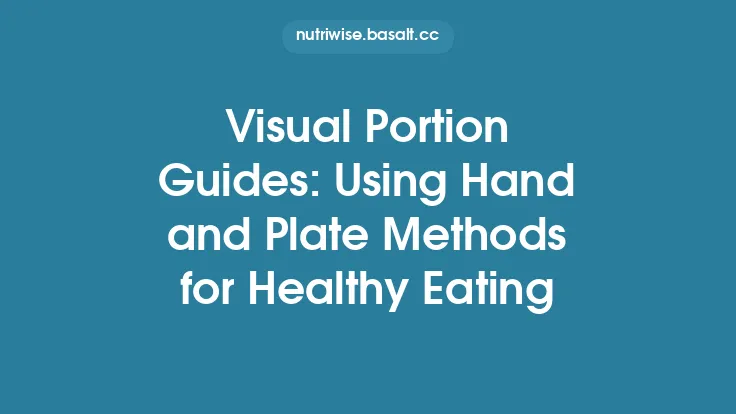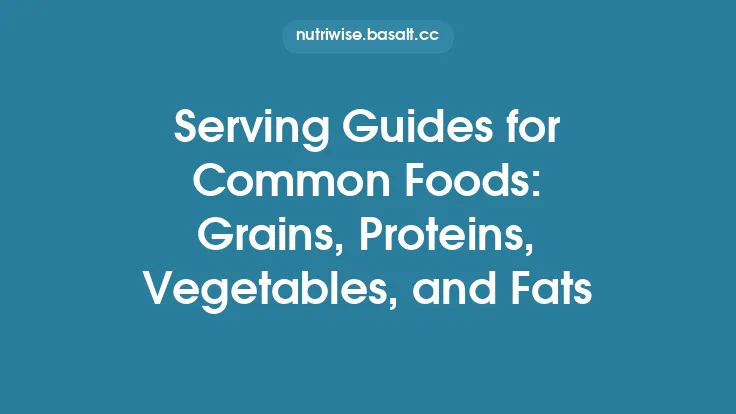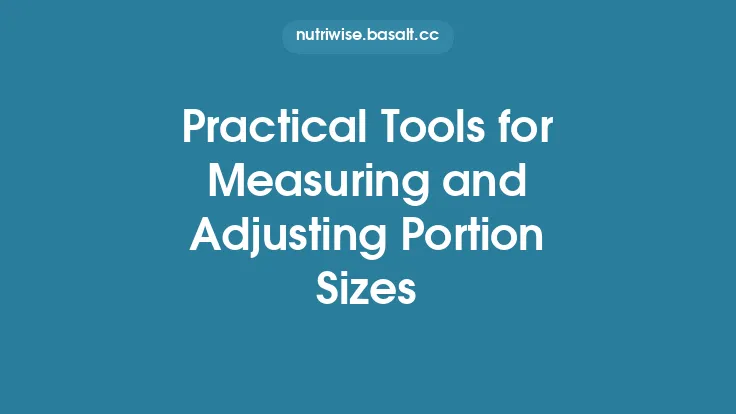When it comes to everyday eating, the most reliable way to keep portions in check is to let your own body become the measuring tool. Visual portion guides—especially the hand‑based and plate‑based methods—translate abstract nutrition concepts into concrete, on‑the‑spot decisions that require no kitchen scale, measuring cups, or calorie‑counting app. By anchoring portion sizes to body landmarks that are always present, these strategies help you maintain a balanced intake of protein, carbohydrates, and fats while respecting the natural variations in your own size and activity level.
Why Visual Guides Work: The Science Behind Body‑Based Estimations
- Proportional Scaling – The human body is a built‑in reference system. A larger hand generally correlates with a larger frame and higher energy needs, while a smaller hand suggests a lower baseline requirement. By scaling food portions to hand size, you automatically adjust for individual differences without needing to calculate exact gram amounts.
- Cognitive Load Reduction – Decision fatigue is a real barrier to consistent healthy eating. Visual cues bypass the need for mental arithmetic, allowing the brain to make rapid, intuitive choices. Studies in behavioral nutrition show that “simple heuristics” like hand‑based portions improve adherence to dietary recommendations compared to numeric targets.
- Portion Memory Reinforcement – Repeatedly pairing a visual cue (e.g., a palm‑sized piece of chicken) with the sensation of satiety creates a mental map. Over time, the brain learns to associate that visual size with a comfortable fullness level, making future decisions faster and more accurate.
- Alignment with Macronutrient Ratios – While the hand‑based method does not replace a detailed macronutrient plan, it can be calibrated to approximate common ratios (e.g., 30 % protein, 40 % carbs, 30 % fat). By assigning specific hand shapes to each macronutrient group, you can approximate a balanced plate without counting grams.
The Hand‑Based Method: A Step‑by‑Step Blueprint
| Hand Portion | Typical Food Types | Approximate Weight* | Visual Cue |
|---|---|---|---|
| Palm (excluding fingers) | Lean meats, fish, tofu, tempeh | 100–150 g | Flat hand, thumb tucked in |
| Fist | Cooked grains, starchy vegetables, legumes | 150–200 g | Closed fist |
| Cupped Hand | Nuts, seeds, dried fruit, avocado | 30–50 g | Hand cupped, fingers together |
| Thumb | Butter, oils, cheese, nut butter | 10–15 g | Thumb length, width of thumb |
\*Weights are averages for an adult with a moderate activity level; they vary with body size and the specific food’s density.
How to Implement It
- Identify Your Hand Reference – Use your dominant hand for consistency. If you have a particularly large or small hand relative to your body, you can adjust by using the non‑dominant hand for a “mid‑size” reference.
- Pre‑Meal Scan – Before you start plating, visualize the hand portions you need for each macronutrient group. For a balanced meal, a common template is:
- Protein: 1–2 palm‑sized portions
- Carbohydrate: 1–2 fist‑sized portions
- Fat: 1–2 thumb‑sized portions (or a cupped‑hand portion of a healthy fat source)
- Assemble the Plate – Place each food item on the plate according to the hand guide. If you’re cooking multiple items (e.g., stir‑fry), you can combine them in a single bowl as long as the total volume matches the hand estimates.
- Adjust for Activity – On high‑intensity training days, add an extra palm of protein or a second fist of carbs. On rest days, you may reduce the fat portion to a single thumb.
- Check Satiety – After eating, note how full you feel. If you consistently feel under‑ or over‑filled, fine‑tune the hand portions (e.g., use three‑quarter of a palm for protein).
Common Pitfalls and How to Avoid Them
- Over‑Estimating the Palm – Many people mistakenly include the fingers when measuring the palm. The correct reference is the flat area of the hand from the base of the thumb to the edge of the pinky, with the fingers together and the thumb tucked in.
- Ignoring Food Density – While the hand method is robust, very low‑density foods (e.g., leafy greens) can fill a fist without delivering many calories. Pair a fist of greens with a thumb of oil or a small protein portion to keep the macronutrient balance.
- One‑Size‑Fits‑All Assumption – Hand size does not perfectly predict caloric needs for extreme body types (e.g., elite athletes, very small children). In those cases, supplement the hand guide with a brief macro calculation.
The Plate‑Based Method: Visualizing Balance on a Single Surface
The plate method translates the same hand‑based concepts onto a familiar visual: a standard dinner plate (approximately 9–10 inches in diameter). By dividing the plate into zones, you can quickly assess whether a meal meets basic macronutrient distribution goals.
Core Plate Layout
| Zone | Percentage of Plate | Food Category | Typical Hand Equivalent |
|---|---|---|---|
| Half (≈50 %) | 50 % | Non‑starchy vegetables | 1–2 fists (depending on density) |
| Quarter (≈25 %) | 25 % | Lean protein | 1 palm |
| Quarter (≈25 %) | 25 % | Starchy carbs or whole grains | 1 fist |
| Optional “dot” | ~5 % | Healthy fats (oil, nuts, avocado) | 1 thumb or cupped hand |
Step‑by‑Step Plate Construction
- Start with the Base – Fill the bottom half of the plate with non‑starchy vegetables (broccoli, peppers, leafy greens). This ensures fiber and micronutrient density while keeping overall calories moderate.
- Add Protein – Place a palm‑sized portion of protein on one side of the remaining half. If you prefer plant‑based protein, a cupped‑hand portion of beans or lentils works well.
- Add Carbohydrate – Fill the opposite side with a fist‑sized serving of a whole grain, starchy vegetable, or legume.
- Finish with Fat – Drizzle a thumb‑sized amount of oil, scatter a few nuts, or add a small slice of cheese.
- Visual Check – Step back and confirm the plate roughly follows the ½‑¼‑¼ rule. If the protein or carb zone looks larger than the vegetable half, adjust accordingly.
Tailoring the Plate for Different Goals
- Higher Protein Needs – Increase the protein zone to cover up to 40 % of the plate, reducing the carb quarter slightly. This is useful for strength‑training phases.
- Low‑Carb Preference – Shrink the carb quarter to a “small bite” (≈½ fist) and expand the vegetable half to 60 % of the plate. Add an extra thumb of healthy fat to maintain satiety.
- Vegetarian/Vegan Meals – Replace the animal protein palm with a combination of legumes (cupped hand) and a plant‑based protein source (e.g., tempeh, tofu) that together occupy the protein quarter.
Advantages Over Traditional Measuring
- Speed – A plate can be assembled in under a minute, ideal for busy weekdays.
- Portability – The visual cue travels with you; you can mentally “see” the plate even when eating out, guiding you to order a salad with protein on the side and a modest portion of starch.
- Portion Consistency – Because most dinner plates are similar in size, the method yields relatively consistent portions across meals.
Limitations to Keep in Mind
- Plate Size Variability – Some restaurants serve meals on larger platters; in those cases, mentally shrink the visual zones to a standard 9‑inch plate.
- Food Shape Distortion – Highly shredded or diced foods can appear larger than they are. Use the hand method as a secondary check for those items.
Integrating Hand‑Based and Plate‑Based Guides
While each method works well on its own, combining them creates a robust “dual‑check” system that minimizes errors.
- Pre‑Meal Planning – Use the hand method to decide how much protein, carb, and fat you need based on activity level.
- Plate Assembly – Translate those hand portions onto the plate zones, ensuring the visual layout matches the calculated amounts.
- Post‑Meal Review – After eating, glance at the leftover plate. If a large portion remains, you may have over‑estimated; if the plate is empty too quickly, consider a modest increase next time.
This feedback loop reinforces accurate portion estimation and gradually refines your internal sense of appropriate serving sizes.
Special Considerations
1. Children and Adolescents
- Hand Scaling – Use the child’s own hand rather than an adult’s. A child’s palm will naturally be smaller, yielding appropriate portion sizes.
- Plate Ratio – Emphasize the vegetable half to foster healthy eating habits early.
2. Older Adults
- Reduced Muscle Mass – May need slightly smaller protein palms but larger vegetable portions for fiber and micronutrients.
- Ease of Use – A plate with clearly demarcated zones (e.g., a divided plate or a plate with printed sections) can simplify visual guidance.
3. Athletes and High‑Performance Individuals
- Multiple Meals – Apply the hand method to each meal and snack, ensuring total daily protein reaches 1.6–2.2 g/kg body weight.
- Carb Loading – On training days, expand the carb quarter to a half‑plate or add a second fist of carbohydrate.
4. Cultural Food Patterns
- Rice‑Centric Cuisines – Treat a fist of cooked rice as the carbohydrate quarter; pair with a palm of fish or tofu and a generous vegetable half.
- Flatbread or Tortilla Meals – Use the hand method to gauge the amount of bread (≈1‑2 fists) and balance with protein and veg on the side.
Frequently Asked Questions
Q: How accurate are hand‑based portions compared to weighing food?
A: For most adults, hand portions fall within ±15 % of the weight of a standard serving. This margin is acceptable for everyday nutrition and far more practical than weighing every bite.
Q: What if my hands are unusually large or small for my body size?
A: Adjust by using the non‑dominant hand as a “moderate” reference, or combine the hand method with a quick visual of a standard serving (e.g., a deck of cards for protein).
Q: Can I use the plate method when eating out?
A: Yes. Visualize a standard plate in your mind and aim to fill half with vegetables, a quarter with protein, and a quarter with carbs. Many restaurants now provide “half‑plate” or “portion‑controlled” options that align well with this approach.
Q: Does the method work for liquid calories (e.g., soups, smoothies)?
A: For liquids, use a cup or your hand’s cupped shape as a reference. A cupped hand of soup roughly equals ½ cup (≈120 ml). Adjust based on the thickness of the liquid.
Q: How do I handle foods with very different densities, like popcorn vs. nuts?
A: Pair a low‑density food (popcorn) with a small amount of higher‑density fat (a thumb of nuts or cheese) to keep the overall macronutrient balance in check.
Final Thoughts
Visual portion guides turn abstract nutrition concepts into concrete, repeatable actions that fit seamlessly into daily life. By anchoring servings to the size of your own hand and the familiar layout of a dinner plate, you gain a portable, low‑effort system that respects individual body size, activity level, and cultural food preferences. While not a substitute for detailed macro tracking in specialized scenarios, the hand‑based and plate‑based methods provide a reliable, evergreen foundation for anyone seeking to eat balanced meals without the constant need for scales, calculators, or nutrition labels. Use them, refine them, and let your own body become the most trustworthy guide in the kitchen.





